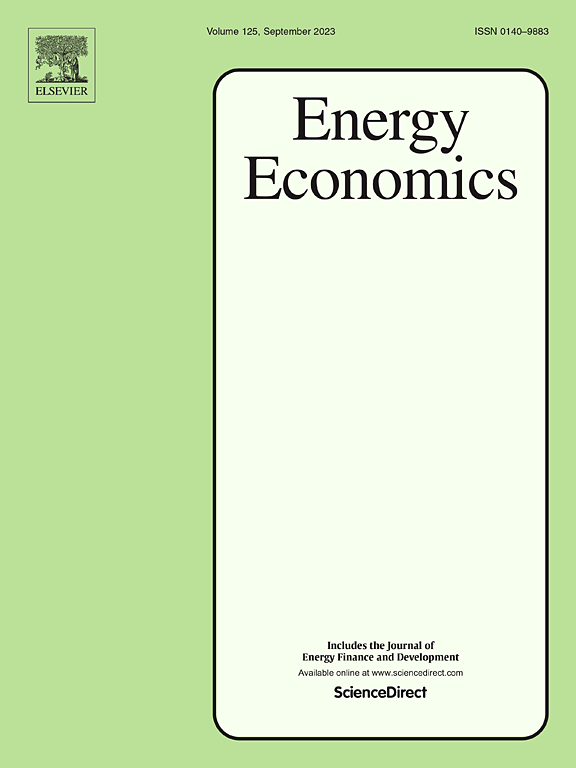On spot revenues, capital structure and trade off theory: Analysing investment risk for contracted renewables
IF 13.6
2区 经济学
Q1 ECONOMICS
引用次数: 0
Abstract
In decarbonising power systems, shifting dynamics require that investors lend careful consideration when structuring plant revenues – or risk violating the constraints of private capital markets. In Australia's National Electricity Market, new variable renewable energy (VRE) plant was traditionally ∼100 % revenue contracted via power purchase agreement (PPA) to facilitate bankability and provide stable returns. However, sharply falling VRE costs have enabled the emergence of a new asset class, viz. VRE with ‘semi-merchant’ cashflows, comprising both PPA contracted and spot market (i.e. merchant) exposed revenue streams. This blended revenue mix, which has dominated new entry in Australia, raises questions vis-à-vis capital structure optimisation as both investors and financiers grapple with the re-introduction of spot revenue variability. In this paper, stochastic modelling techniques are applied to stress-test new entrant wind plant cashflows under a full spectrum of PPA cover levels and within capital market (i.e. project finance) constraints. Under ordinary market conditions, a run-of-plant PPA with at least ∼50 % revenue cover is found sufficient to mitigate technical default risk and secure commercial debt levels. However, the relationship between PPA cover and default (i.e. distress cost) risk is also found to be decidedly non-linear, with some semi-merchant structures capable of supporting debt levels equivalent to 100 % PPA plant without introducing material default risk – an unexpected finding. Presented results identify the limits of a PPA to extract equity capital risk from a stand-alone VRE asset and, by implication, the limits of cost of capital optimisation in line with Modigliani and Miller's seminal writings on capital structure.
现货收入、资本结构和交易理论:分析签约可再生能源的投资风险
在使电力系统脱碳方面,不断变化的动态要求投资者在构建电厂收入结构时慎重考虑,否则就有违反私人资本市场约束的风险。在澳大利亚国家电力市场,新的可变可再生能源(VRE)电厂传统上通过购电协议(PPA)签订约100%的收入,以促进可融资性并提供稳定的回报。然而,VRE成本的急剧下降使得一种新的资产类别出现,即具有“半商人”现金流的VRE,包括PPA合同和现货市场(即商人)暴露的收入流。这种混合收入组合在澳大利亚的新进入者中占主导地位,这引发了对-à-vis资本结构优化的质疑,因为投资者和金融家都在努力应对重新引入现货收入可变性的问题。在本文中,随机建模技术应用于压力测试新进入的风电场在PPA覆盖水平和资本市场(即项目融资)约束下的现金流。在一般的市场条件下,至少有50%收入覆盖率的电厂运行PPA足以降低技术违约风险并确保商业债务水平。然而,PPA承保范围与违约(即违约成本)风险之间的关系也被发现明显是非线性的,一些半商业结构能够支持相当于100% PPA电厂的债务水平,而不会引入重大违约风险——这是一个意想不到的发现。提出的结果确定了购电协议从独立VRE资产中提取股权资本风险的限制,并暗示了与Modigliani和Miller关于资本结构的开创性著作一致的资本优化成本的限制。
本文章由计算机程序翻译,如有差异,请以英文原文为准。
求助全文
约1分钟内获得全文
求助全文
来源期刊

Energy Economics
ECONOMICS-
CiteScore
18.60
自引率
12.50%
发文量
524
期刊介绍:
Energy Economics is a field journal that focuses on energy economics and energy finance. It covers various themes including the exploitation, conversion, and use of energy, markets for energy commodities and derivatives, regulation and taxation, forecasting, environment and climate, international trade, development, and monetary policy. The journal welcomes contributions that utilize diverse methods such as experiments, surveys, econometrics, decomposition, simulation models, equilibrium models, optimization models, and analytical models. It publishes a combination of papers employing different methods to explore a wide range of topics. The journal's replication policy encourages the submission of replication studies, wherein researchers reproduce and extend the key results of original studies while explaining any differences. Energy Economics is indexed and abstracted in several databases including Environmental Abstracts, Fuel and Energy Abstracts, Social Sciences Citation Index, GEOBASE, Social & Behavioral Sciences, Journal of Economic Literature, INSPEC, and more.
 求助内容:
求助内容: 应助结果提醒方式:
应助结果提醒方式:


